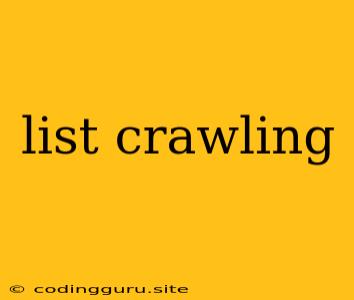What is List Crawling?
List crawling is a technique used to extract data from web pages that contain lists of items. This data could be anything from product names and prices to news headlines and article summaries. It's a powerful technique for web scraping and can be used for various purposes, including:
- Market research: Analyze product pricing, competitor analysis, and customer reviews.
- Content aggregation: Gather news articles, blog posts, or social media updates on specific topics.
- Lead generation: Extract contact information from websites.
- Data analysis: Compile data sets for research or analysis.
Why Is List Crawling Necessary?
While manually copying and pasting data from websites can be done for a few items, it becomes time-consuming and inefficient for large amounts of data. This is where list crawling comes in. It automates the process, allowing you to quickly extract the information you need.
How Does List Crawling Work?
List crawling typically involves the following steps:
- Identify the target website: Determine the website containing the list of data you want to extract.
- Inspect the website's HTML structure: Analyze the website's source code to identify the HTML elements containing the desired data. This usually involves using developer tools in your web browser.
- Write a web scraping script: Use a programming language like Python or Node.js to create a script that navigates to the target website, locates the data, and extracts it.
- Parse the extracted data: Clean and organize the extracted data into a structured format, such as a spreadsheet or database.
Example: Scraping Product Data from an E-commerce Website
Let's say you want to extract product names, prices, and ratings from an e-commerce website. Here's how you can approach it:
- Identify the target website: Choose the e-commerce website with the products you want to scrape.
- Inspect the HTML structure: Open the website in your browser and use the developer tools to inspect the HTML code. Look for elements like
<div>,<span>, or<li>that contain the product information. - Write a web scraping script: Use a Python library like
BeautifulSouporRequeststo create a script that:- Fetches the HTML content of the product listing page.
- Parses the HTML to extract the data from the identified elements.
- Stores the extracted data in a list or dictionary.
- Parse the extracted data: Process the extracted data, such as cleaning up text, converting prices to numerical values, and storing it in a structured format like a CSV file.
Challenges in List Crawling
While list crawling is powerful, it presents certain challenges:
- Website Structure Changes: Websites can change their HTML structure, making your script unusable.
- Dynamic Content: Websites using JavaScript to dynamically load data may require additional techniques to scrape the data.
- Rate Limiting: Websites often implement rate limiting to prevent scraping bots from overloading their servers.
- Legal and Ethical Considerations: Always respect websites' terms of service and avoid scraping sensitive data or causing harm to the website.
Tips for Successful List Crawling
- Respect website terms of service: Ensure your scraping activity complies with the website's policies.
- Use a reliable web scraping library: Python's
BeautifulSoupandRequestsare popular choices, while Node.js offers libraries likecheerioandrequest. - Handle website structure changes gracefully: Consider using flexible selectors in your script to adapt to changes.
- Implement rate limiting: Respect website limitations by implementing delays between requests to avoid overloading their servers.
- Avoid scraping sensitive data: Do not extract personal information or other data that could be misused.
Conclusion
List crawling is a valuable tool for web scraping and data extraction. By understanding the process, challenges, and tips, you can leverage this technique to gather valuable data from websites efficiently and ethically. However, remember to always be mindful of website terms of service and legal considerations to ensure responsible data collection.
